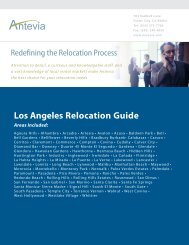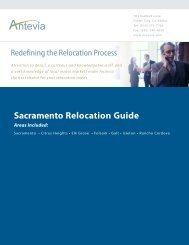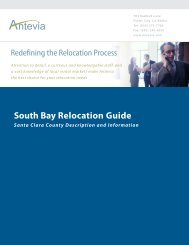San Francisco Relocation Guide - Antevia
San Francisco Relocation Guide - Antevia
San Francisco Relocation Guide - Antevia
You also want an ePaper? Increase the reach of your titles
YUMPU automatically turns print PDFs into web optimized ePapers that Google loves.
External Links<br />
Visitacion Valley Community Development Centre<br />
Western Addition, <strong>San</strong> <strong>Francisco</strong>,<br />
California<br />
From Wikipedia, the free encyclopedia<br />
A southern view from Alta Plaza Park, which is in the Pacific Heights neighborhood.<br />
Most of the valley in the central part of this image is in the Western Addition<br />
neighborhood. In the background on the right can be seen Sutro Tower, which is west of<br />
Twin Peaks. The darker hill to the left and slightly more in the foreground is Buena Vista<br />
Heights, which is directly south of Haight Street (between the Haight-Fillmore and<br />
Haight-Ashbury neighborhoods). Cathedral Hill is visible to the left, just west of Van<br />
Ness Avenue and north of Hayes Valley.<br />
The Western Addition is a neighborhood in <strong>San</strong> <strong>Francisco</strong>, California. Historically, it<br />
was an addition to the city west of Van Ness Avenue sandwiched between the Haight<br />
district and Pacific Heights. The area was first developed around the turn of the 20th<br />
century as a middle-class suburb served by cable cars. Aside from Hayes Valley, it<br />
survived the 1906 <strong>San</strong> <strong>Francisco</strong> earthquake with its Victorian-style buildings largely<br />
intact. Today, the term Western Addition is generally used in two ways: to denote the<br />
development's original geographic area, and to denote the eastern portion of the<br />
neighborhood (also called the Fillmore District) that was redeveloped in the 1950's.<br />
Those who use the term in the former sense generally consider its (relatively ill-defined)<br />
boundaries to be Van Ness Avenue on the east, Masonic Avenue on the west, Post Street<br />
on the north, and Oak Street on the south. From there, it is often divided into smaller







